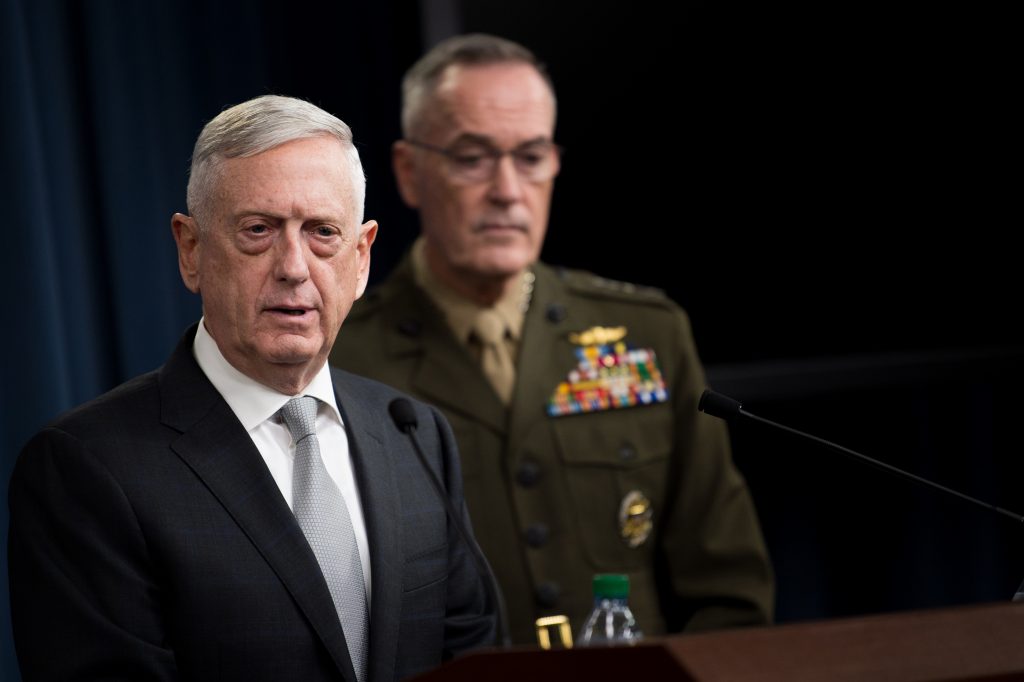Mattis & Dunford On The Long, Uncertain Road To Space Force
Posted on

Secretary of Defense Jim Mattis and the Chairman of the Joint Chiefs of Staff, Gen. Joseph Dunford, brief the press
UPDATED to clarify policy change on Space Command PENTAGON: President Trump’s vision of a new Space Force will take a long time to realize, the Secretary of Defense and Chairman of the Joint Chiefs made clear this morning. Even the near-term first step towards an independent service has become less ambitious: Instead of creating a stand-alone command equal in stature to, say, Strategic Command, the top leaders talked today about what’s known in the Pentagon as a sub-unified command, subordinate to STRATCOM.
It will take “a few months” just to put together a detailed plan to create a new space command subordinate to US Strategic Command, Gen. Joseph Dunford said; he didn’t say how long it would then take to implement. There’s no cost estimate for that move yet, let alone for creating a full-up Space Force. On that broader subject of creating a new armed service, Mattis would say only “we are working now with Congress on our way ahead.”
This is as close to a timeline as we’re likely to get. The Pentagon’s lack of enthusiasm for a space force is not new, although Mattis took pains with reporters two weeks ago to argue he was never actually against the idea. Congress, which would have to legislate creation of a new service, is split, with enthusiasm in the House countered by skepticism in the Senate. The famously candid Vice-Chairman of the Joint Chiefs, Gen. Paul Selva, said outright that it would be “unprecedented” if Congress passed the necessary laws within a year, but this is the most detail we’ve heard from his superiors on the subject.
It’s worth quoting Mattis and Dunford at some length and dissecting their remarks, precisely because they’ve said so little so far.
Mattis first brought up space without being prompted, in his opening statement — but note the lukewarm language.
“We have worked with Congress and the White House to define the evolving space problem that we confront,” the secretary began. The implication here is that the Pentagon is a third party “work(ing) with” both the legislature and Trump, not simply an extension of the White House’s will. That implication may be unintentional on Mattis’s part, but it’s still a pretty accurate reflection of what’s actually happening beneath the public statements of support for the president’s “vision.”
“Now we are implementing the National Defense Authorization Act and its provision for unified space command,” Mattis continued, “in line with the president’s vision for a needed Space Force, while revising our vision for defending our assets in space and revising antiquated space acquisition processes.”
Mattis concluded his prepared remarks on the Space Force saying: “We are working now with Congress on our way ahead with regard to needed legislation for a separate department.”
There’s an important nuance here. One of the earlier proposals from Congress was to create a Space Corps, not a Space Force, as a new military service within the Air Force Department, just as the Marine Corps is an independent service within the Navy Department. (In turn, the Air Force, Navy, and Army Departments, plus a host of other agencies, make up the Department of Defense, whose secretary is the only one with a seat in the cabinet). President Trump’s proposal for a Space Force envisions its being its own department, and Mattis is confirming here that’s what is on the table with Congress.
About 40 minutes later, after Mattis and Dunford gave a tour de horizon of everything the US military is doing around the world and got peppered with questions — mostly about Afghanistan and Yemen — the subject of a Space Force came up again. Specifically, one reporter asked if the Pentagon could provide any cost estimate for standing up a new service.
“No, I cannot,” Mattis said. “I will tell you that setting up the combatant command will not be that expensive because we’ll build out on what we have right now — I’ll let the chairman speak on this in a moment — but we have not done the costing estimates.”
What Mattis means is that the new Space Command is not being created from scratch, but rather out of existing headquarters and command centers, many of them already under STRATCOM.
“That’s underway right now,” Mattis said. “We’ve already commenced the effort. I don’t want to give you an off-the-cuff number.” However, when they get to the point when it’s time to create a unified command there will be costs, as there have been with the creation of Cyber Command.
Dunford took his cue from Mattis: “There is a provision of the National Defense Authorization Act that requires us to stand up a sub-unified command (under STRATCOM). In fact I recently, just yesterday, met with the key leaders of the department to work through the details of that. We’re still a few months away from standing up that command and coming to the secretary with a recommendation as to the specific details of doing that.” Of course, even if Sec. Mattis approves that recommendation immediately, it’ll still be months more, at least, to implement it.
But that wasn’t the plan a few weeks ago. As outlined by Mattis’ deputy, Patrick Shanahan, on Aug. 9. the Pentagon was going to go straight to an independent command.
“We made the recommendation, and the secretary accepted it, that we accelerate the standup of a unified command for space, that we not necessarily go through all the intermediate steps of a sub-unified command (emphasis added) and grind through what those authorities might look like, but that we actually stand up a group that would look at what the authority’s responsibilities and missions of a unified space command would be and how quickly we could execute those,” Shanahan told reporters in a briefing on his congressionally-mandated report for a Space Force.
That’s just one example of how rapidly this discussion is evolving. It’s moving so quickly that not everyone knows what is happening or what the final goal is.
“We don’t have a full cost right now, ” Dunford reiterated, but when we get one, “we’ll certainly share that with you.”
Again, Dunford’s talking about an estimate for the cost of the new command, not a new service. In fact, both he and Mattis specifically referred to the recently passed NDAA legislation, which calls for creating a space command subordinate to Strategic Command, a “sub-unified command” as Dunford put it. Mattis also mentioned the idea of a “combatant command,” which implies an entity co-equal to STRATCOM rather than subordinated to it, as the Pentagon laid out earlier this month — but it doesn’t sound like they’re actually working on that more elevated version of a space command yet.
The cost of a full-fledged Space Force depends on what Congress is willing to legislate, if it legislates anything at all. A few weeks ago, Deputy Defense Secretary Patrick Shanahan offered a guesstimate of “billions.” But the uncertainties are so immense there’s no way to tell when or if a Space Force will be created, let alone what it’ll cost.
Subscribe to our newsletter
Promotions, new products and sales. Directly to your inbox.




